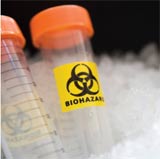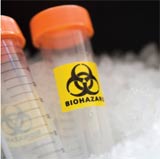
Hazards and Hoaxes
Biochemical threats require ubiquitous detection systems
- By Robert Hahn
- Mar 01, 2009
 Less than eight years ago, anthrax letters killed five people, sickened many others and disrupted mail operations nationwide. Despite large investments in time and treasure, suspicious white powder continues to bedevil security executives and mail center managers worldwide.
Less than eight years ago, anthrax letters killed five people, sickened many others and disrupted mail operations nationwide. Despite large investments in time and treasure, suspicious white powder continues to bedevil security executives and mail center managers worldwide.
Last year was particularly painful for all concerned. A series of white powder envelopes shut down banks, government offices and media organizations. Even the worldwide news media are aware of these incidents— tracking of the words “white powder hoax” and “anthrax” finds more than a thousand mentions in the media every week.
In 2008, more than 50 letters containing white powder were mailed to JP Morgan Chase bank facilities across the country. The FDIC office and Office of Thrift Supervision in Dallas, and the Federal Home Loan Bank in Atlanta were also targeted in these attacks.
The outbreak of white powder letters continued when suspicious letters were sent to governors in more than 40 states. Most were determined to have contained bleached flour. State Department embassies and consulates in more than 18 countries received white powder letters as the year ended. With the exception of a lone perpetrator in Sacramento, Calif., the person or people responsible for these incidents remains at large.
As if the outbreak of white powder letters was not enough to cause concern, the bipartisan Commission on the Prevention of Weapons of Mass Destruction Proliferation and Terrorism also released its report, “World at Risk,” in December 2008. The report focused on biological and nuclear risks, causing the commission to predict that “a weapon of mass destruction will be used in a terrorist attack somewhere in the world by the end of 2013.” Homeland Security Secretary Michael Chertoff echoed the commission’s view at a December press conference when he predicted that more terrorists will soon learn how to make biological weapons and dirty bombs.
Detecting and defending oneself against white powder threats remains difficult and potentially dangerous. Whether the powder is anthrax or flour, it can have the same type of disruptive effect on operations and employees. Therefore, defense against these fundamentally different types of threats always has the same core components: detection, containment, identification and decontamination.
The number of systems available to HAZMAT and other first responders to identify suspicious substances such as white powder has grown dramatically. The Department of Homeland Security’s authorized equipment list for biological detection equipment now describes 87 different samplers, kits and screening devices.
Systems designed to protect us from hazardous substances such as anthrax all have two basic components: a collection system and an identification system. Northrop Grumman’s biohazard detection system, now widely deployed throughout U.S. Postal Service processing centers, contains a hood that collects an air sample near mail being processed and sends it to a system built by Cepheid Inc. that identifies the presence of anthrax by its DNA.
Systems such as the Bio-Seeq Mail Sentry Biological Detection System built by Smiths Detection Inc. and the ASAP II System developed by Research International Inc. perform similar processes using slightly different identification technologies. Other approaches collect ambient air samples from mail centers—or entire buildings—for identification. Examples include the AirSentinel BioAerosol Sensor from ICx Technologies, which acts as the biological equivalent of a smoke detector and sends an alarm if it detects elevated levels of airborne biological material.
Most of the systems introduced since 2001 are designed to detect actual pathogen contamination or help first responders identify the substance; however, by the time first responders have arrived on the scene, the damage has already been done. Mail center personnel have been removed from the scene, businesses have been disrupted and employees are struggling to manage the emotional impact associated with potential exposure to a weapon of mass destruction.
Security managers employ a range of containment approaches from personal downdraft tables to roomsized facilities. DualDraw builds an air filtration table integrating both localized containment and several detection systems. Full mail-center-sized negative pressure air rooms are being built by American Safe Air Inc. for government agencies, Fortune 500 companies and nonprofit organizations.
One unique approach to combining containment, collection and identification is the low-cost, DHS SAFETY Act designated Biohazard Isolation and Screening System built and marketed by Pitney Bowes Inc. It isolates mail from facilities and employees and maintains it in quarantine until a highly sensitive and specific DNA or laboratory test determines that the mail is safe.
Decontamination is the process whereby biohazards are cleaned up in already contaminated mail facilities. There is another approach to decontamination that involves a rather unique system developed by BioDefense Corp. of Boston. MailDefender is designed to eliminate the anthrax threat by neutralizing it at the source. The easy-to-use system is a safe, proven disinfection technology that kills and/or neutralizes anthrax, smallpox and ricin—all dangerous substances.
Unlike other systems that focus only on detection and identification, MailDefender uses a combination of disinfection technologies, including electromagnetic irradiation, ultraviolet, microwave, high-intensity broadbeam, infrared and other light sources to kill biological pathogens that may be in a letter. Whether the letter contains anthrax or a sugar substitute, the recipient is protected when opening it. MailDefender is designed to comply with Homeland Security, federal law enforcement and judicial agencies recommendations as a first line of defense against biochemical assault.
Ideally suited for small batches of mail, an individual MailDefender system decontaminates up to 200 pieces, or 3 pounds, of mail in less than an hour.
Whether hazard or hoax, envelopes filled with suspicious white powder are obvious attempts at biochemical assaults with the intent to harm, disrupt or even kill. The detection, identification, containment and decontamination systems that have been created to deal with this problem are making the task somewhat more manageable, but much remains to be done.
It has been seven years since the original letters paralyzed America—but we’re still counting.
This article originally appeared in the issue of .